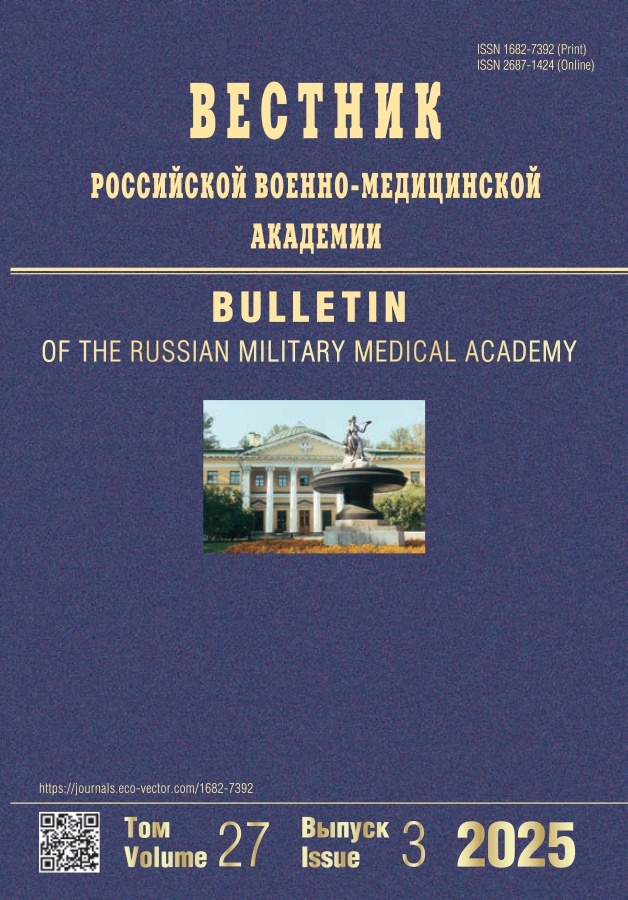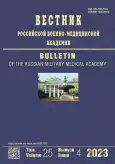Диагностические критерии эндотелиальной дисфункции, субклинического атеросклероза и их взаимосвязь с полиморфизмом генов NOS3 и HIF1A у военнослужащих в экстремальных условиях арктической зоны
- Авторы: Лемещенко А.В.1, Гурина О.И.2, Цыган В.Н.1, Макаров А.Б.1, Криволуцкая Т.А.3, Берг Д.В.1, Кириллов А.С.4
-
Учреждения:
- Военно-медицинская академия имени С. М. Кирова
- Национальный медицинский исследовательский центр психиатрии и наркологии имени В. П. Сербского
- 1477-й Военно-морской клинический госпиталь
- 441-й Военный госпиталь
- Выпуск: Том 25, № 4 (2023)
- Страницы: 583-594
- Раздел: Оригинальное исследование
- URL: https://journal-vniispk.ru/1682-7392/article/view/253750
- DOI: https://doi.org/10.17816/brmma430302
- ID: 253750
Цитировать
Аннотация
Оценивается состояние эндотелия артериальных сосудов на фоне субклинического атеросклероза и их взаимосвязь с полиморфизмом генов у военнослужащих, проходящих службу в условиях арктического климатического пояса в зависимости от продолжительности службы. Обследован 251 военнослужащий мужского пола в возрасте 28–40 лет. В группу военнослужащих арктического климатического пояса вошло 99 человек, разделенных на три группы по продолжительности военной службы в Арктике: 1-я группа — 8 (8 %) человек, до 5 лет; 2-я группа — 21 (21 %) человек, от 5 до 10 лет; 3-я группа — 70 (71 %) человек, более 10 лет. В контрольную группу вошли 152 военнослужащих из умеренного климатического пояса в возрасте 28–40 лет. Всем обследуемым проведены: проба с реактивной гиперемией, эластография; измерение толщины комплекса интима-медиа на плечевой артерии; ультразвуковое исследование общих сонных артерий; фотоплетизмография; пульсоксиметрия; спирометрия; антропометрия; биохимический анализ крови; определение полиморфизма генов с помощью полимеразной цепной реакции. Установлено, что эндотелийзависимая вазодилатация у военнослужащих 2-й и 3-й групп была меньше в 1,7 и 2,7 раза по сравнению с военнослужащими 1-й группы (p < 0,05). У 11 (16 %) военнослужащих 3-й группы обнаружено утолщение комплекса интима-медиа более чем на 50 % от прилежащих участков общих сонных артерий. Во 2-й и 3-й группах общий холестерин крови превышал на 10 и 14 % этот показатель в 1-й группе (р < 0,05). Жесткая стенка артерий была у носителей генотипов Т/Т генов HIF1A и NOS3, а максимально эластичная — у генотипов G/T гена NOS3 и С/С гена HIF1A. В целом у военнослужащих, проходящих службу в арктическом климатическом поясе с продолжительностью службы более 10 лет выражена эндотелиальная дисфункция, жесткость периферических сосудов с явлениями субклинического атеросклероза, особенно у военнослужащих с генотипом Т/Т гена HIF1A (rs11549465) и NOS3 (rs1799983). Полагаем, что ведущим патогенетическим звеном эндотелиальной дисфункции артериальных сосудов является резистентность миоцитов к воздействию экспрессируемых сосудистым эндотелием факторов вазодилатации, в частности оксида азота. Чем больше стаж службы военнослужащих в условиях полярной гипоксии, тем вероятность развития эндотелиальной дисфункции выше.
Полный текст
Открыть статью на сайте журналаОб авторах
Алексей Викторович Лемещенко
Военно-медицинская академия имени С. М. Кирова
Email: lav_1981@mail.ru
ORCID iD: 0000-0001-6786-2332
SPIN-код: 8534-0822
Scopus Author ID: 593499
ResearcherId: HZG-6169-2023
кандидат медицинских наук
Россия, Санкт-ПетербургОльга Ивановна Гурина
Национальный медицинский исследовательский центр психиатрии и наркологии имени В. П. Сербского
Email: olga672@yandex.ru
ORCID iD: 0000-0001-6942-5531
SPIN-код: 7953-1609
Scopus Author ID: 306253
ResearcherId: H-2401-2013
доктор медицинских наук, профессор
Россия, МоскваВасилий Николаевич Цыган
Военно-медицинская академия имени С. М. Кирова
Email: vn-t@mail.ru
ORCID iD: 0000-0003-1199-0911
SPIN-код: 7215-6206
Scopus Author ID: 645584
ResearcherId: IQT-0859-2023
доктор медицинских наук, профессор
Россия, Saint PetersburgАндрей Борисович Макаров
Военно-медицинская академия имени С. М. Кирова
Автор, ответственный за переписку.
Email: m200@list.ru
ORCID iD: 0000-0003-2270-3578
SPIN-код: 2226-7145
Scopus Author ID: 1136650
ResearcherId: А-4130-2014
кандидат медицинских наук
Россия, Санкт-ПетербургТатьяна Александровна Криволуцкая
1477-й Военно-морской клинический госпиталь
Email: tat.beloz@yandex.ru
ORCID iD: 0000-0003-4988-2414
SPIN-код: 4531-7254
Scopus Author ID: 1114016
ResearcherId: HDM-1333-2022
аспирант
Россия, Петропавловск-КамчатскийДмитрий Викторович Берг
Военно-медицинская академия имени С. М. Кирова
Email: d.v.berg@mail.ru
ORCID iD: 0009-0002-7815-4643
SPIN-код: 6488-4643
Scopus Author ID: 1191072
ResearcherId: HZDG-3562-2023
преподаватель
Россия, Санкт-ПетербургАлексей Станиславович Кириллов
441-й Военный госпиталь
Email: kirillovalexiy@yandex.ru
ORCID iD: 0000-0001-9942-0344
SPIN-код: 4886-4998
Scopus Author ID: 1197348
ResearcherId: HZL-7507-2023
начальник инфекционного отделения
Россия, Южно-СахалинскСписок литературы
- Васина Л.В., Петрищев Н.Н., Власов Т.Д. Эндотелиальная дисфункция и ее основные маркеры // Регионарное кровообращение и микроциркуляция. 2017. Т. 16, № 1. С. 4–15. doi: 10.24884/1682-6655-2017-16-1-4-153
- Ким А.П., Котельников В.Н., Макаров А.Б., и др. Вазомоторная функция сосудистого эндотелия и состояние легочной гемодинамики у больных внебольничной пневмонией с различной степенью тяжести эндогенной интоксикации // Современные проблемы науки и образования. 2015. № 2–1. С. 82. doi: 10.17513/spno.2015.1.122-18749
- Семенов А.А., Лемещенко А.В., Криштоп В.В. Влияние общего стажа военной службы и службы в экстремальных климатических условиях на показатели сердечно-сосудистой системы // Педиатр. 2023. Т. 14, № 1. С. 81–88. doi: 10.17816/PED14181-88
- Юпатов Е.Ю., Курманбаев Т.Е., Тимошкова Ю.Л. Современное понимание функции и дисфункции эндотелия сосудов. Обзор литературы // Российский медицинский журнал. 2022. № 3. С. 20–23.
- Лемещенко А.В., Цыган В.Н., Бурлов Н.Н., Гурская О.Е. Влияние носительства полиморфных вариантов гена рецептора серотонина 2А HTR2A (rs6313) на развитие артериальной гипоксемии и эндотелиальной дисфункции у военнослужащих в условиях хронической гипобарической гипоксии // Военно-медицинский журнал. 2023. Т. 344, № 1. С. 78–84. doi: 10.52424/00269050_2023_344_1_78
- Janaszak-Jasiecka A., Siekierzycka A., Płoska A., et al. Endothelial Dysfunction Driven by Hypoxia-The Influence of Oxygen Deficiency on NO Bioavailability // Biomolecules. 2021. Vol. 11, No. 7. P. 982. doi: 10.3390/biom11070982
- He M., Ma S., Cai Q., et al. Hypoxia induces the dysfunction of human endothelial colony-forming cells via HIF-1α signaling // Respir Physiol Neurobiol. 2018. No. 247. P. 87–95. doi: 10.1016/j.resp.2017.09.013
- 8.Rodriguez-Miguelez P., Lima-Cabello E., Martínez-Flórez S., et al. Hypoxia-inducible factor-1 modulates the expression of vascular endothelial growth factor and endothelial nitric oxide synthase induced by eccentric exercise // J Appl Physiol (1985). 2015. Vol. 118, No. 8. Р. 1075–1083. doi: 10.1152/japplphysiol.00780.2014
- Pirri D., Fragiadaki M., Evans P.C. Diabetic atherosclerosis: is there a role for the hypoxia-inducible factors? // Biosci Rep. 2020. Vol. 40, No. 8. BSR20200026. doi: 10.1042/BSR20200026
- Theodorakopoulou M., Raptis V., Loutradis C., Sarafidis P. Hypoxia and Endothelial Dysfunction in Autosomal-Dominant Polycystic Kidney Disease // Semin Nephrol. 2019. Vol. 39, No. 6. Р. 599–612. doi: 10.1016/j.semnephrol.2019.10.009
- Wan Y., Li X., Slevin E., et al. Endothelial dysfunction in pathological processes of chronic liver disease during aging // FASEB J. 2022. Vol. 36, No. 1. P. e22125. doi: 10.1096/fj.202101426R
- Janaszak-Jasiecka A., Siekierzycka A., Bartoszewska S., et al. eNOS expression and NO release during hypoxia is inhibited by miR-200b in human endothelial cells // Angiogenesis. 2018. Vol. 21, No. 4. Р. 711–724. doi: 10.1007/s10456-018-9620-y
- Zhu Y., Ni T., Lin J., et al. Long non-coding RNA H19, a negative regulator of microRNA-148b-3p, participates in hypoxia stress in human hepatic sinusoidal endothelial cells via NOX4 and eNOS/NO signaling // Biochimie. 2019. Vol. 163. Р. 128–136. doi: 10.1016/j.biochi.2019.04.006
- Замечник Т.В., Рогова Л.Н. Гипоксия как пусковой фактор развития эндотелиальной дисфункции и воспаления сосудистой стенки (обзор литературы) // Вестник новых медицинских технологий. 2012. Т. 19, № 2. С. 393–394.
- Wong B.W., Marsch E., Treps L., et al. Endothelial cell metabolism in health and disease: impact of hypoxia // EMBO J. 2017. Vol. 36, No. 15. Р. 2187–2203. doi: 10.15252/embj.201696150
- Celermajer D.S., Sorensen K.E., Gooch V.M., et al. Non-invasive detection of endothelial dysfunction in children and adults at the risk of atherosclerosis // Lancet 1992. Vol. 340, No. 8828. Р. 1111–1115. doi: 10.1016/0140-6736(92)93147-f
- Лемещенко А.В., Криштоп В.В., Семенов А.А., Никонорова В.Г. Связь индекса Рорера у военнослужащих, проходящих военную службу в разных климатических зонах, с оценкой функции сердечно-сосудистой системы // Современные проблемы науки и образования. 2023. № 3. С. 18. doi: 10.17513/spno.32659
Дополнительные файлы









